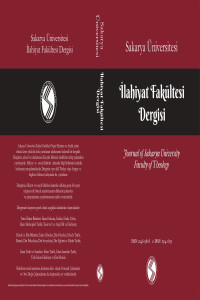İbn Kesîr’in el-Bidâye ve’n-nihâye’sinin Siyer Kısmında Başvurduğu Muhteva Tenkidi Kıstasları ve Garâbet Tabirini Muhteva Tenkidi Bağlamında Kullanımı
The Content Criticism Criteria of Ibn Kathīr in the Sīra Section of His Kitāb al-Bidāya wa al-nihāya and the Usage of the Term Gharīb in the Context of Content Criticism
Author(s): Mehmet Ali ÇalganSubject(s): Theology and Religion, Islam studies
Published by: Sakarya üniversitesi
Keywords: Hadith; Matn criticism; Content criticism; Ibn Kathīr; al-Bidāya wa al-nihāya;
Summary/Abstract: The Sīra section of the work named al-Bidāya wa al-nihāya by Ibn Kathīr (d. 774/1373), who wrote many invaluable works in various branches of Islamic sciences, deals with the life, manners and miracles of the Prophet (pbuh) in a comprehensive manner. In this work, Ibn Kathīr criticized the hadith and sīra narrations very carefully and expressed the problems that attracted his attention regarding the content of these narrations. It is observed that he made recourse to a number of criteria such as conflict with the Qurʾān, authentic hadiths and sunna, reasoning and historical facts, idjmāʿ and basic teachings of the religion, dissimilarity to the words of prophethood/companions, narration of an event witnessed by a large group by only one person, narration of an event by only one person for which there are a number of reasons for it to be widely circulated, inconsistency within the text, simplicity of words, problems regarding the meaning, intuitive criticism and inclusion of isrāʾīliyyāt. In addition, it has been seen that Ibn Kathīr utilized expressions such as “gharīb” and “gharīb seriously”, from time to time in the context of criticizing the content explicitly rather than to point out the singularity of the hadith. Ibn Kathīr uses the expression “gharīb seriously” in cases where the content of the hadith poses a serious problem. When we look at the usages such as “seriously gharīb, even munkar or false” and "seriously munkar, even lie”, it is inferred that as the content problem in particular hadith increases, the expressions “munkar” and in more advanced cases “lie” is preferred instead of the term “gharīb”. In our study, although we cannot include all the examples that we identified in the main text, the fact that we have shared thirty-seven examples from those we selected may give an idea about the extent of Ibn Kathīr’s content criticism. Considering the importance of the subject of content criticism today and the discussions on this subject, we think that examining these criteria extensively and carefully and presenting convincing and sufficient evidence will make a significant contribution to clarifying these discussions. Ibn Kathīr also subjected nineteen Sahīhayn hadiths to content criticism, revealed the incorrectness of some of the information in several examples and tried to explain the problematic points of others. There are some claims that the hadith scholars have not sufficiently used reasoning in hadith criticism. In contrast to these claims, Ibn Kathīr utilized reasoning in the criticism of quite a number of hadiths. For this reason, we have emphasized those examples where Ibn Kathīr used the reasoning criterion in hadith criticism. Ibn Kathīr appealed to reason in criticizing the text by using clear expressions such as “it is meaningless”, “it is extremely unreasonable and impossible” in some examples, and in some other examples by explaining in a more detailed way why the text is far from being reasonable. It might be useful to give an example of the use of this criterion for a better idea. In a hadith, it is stated that in one of the battles, people carried one brick, and Salmān al-Fārisī carried two bricks. Ibn Kathīr points out the irrationality in this situation as follows: “It is pointless to carry bricks while digging a ditch. It looks like the narrator got it mixed up.” Ibn Kathīr took into consideration the criterion of conformity with the Qurʾān, both in positive and negative terms. In other words, in some examples, he judged the weakness of the text by showing the existence of the problem of opposition to the Qurʾān, and in some other examples, he judged the sihha of the text by showing its conformity to the Qurʾān. The variety of the content criticism criteria that Ibn Kathīr used, the numerical abundance of hadiths that are criticized in view of their content and the fact that the hadiths in the most reliable hadith sources such as Sahihayn can also be criticized are quite surprising. For this reason, we hope that this research’s result will positively contribute to correcting the perception that hadith scholars are hesitant and unsuccessful in content criticism and determining the truth more accurately. This research, which we conducted specifically on Ibn Kathīr, has also shown the need to examine the works of great hadith scholars such as Ibn Kathīr, who are prominent in hadith criticism, more carefully. As a matter of fact, the findings obtained from the works of hadith scholars in which they criticize hadiths will make more concrete contributions to the discussions related to content criticism. Briefly, the main goal of the article is to analyze the content criticism criteria used by Ibn Kathīr in the Sīra section of his work in a systematic and comprehensive way and to scrutinize the use of the term gharīb in the context of content criticism.
Journal: Sakarya Üniversitesi İlahiyat Fakültesi Dergisi (SAUIFD)
- Issue Year: 26/2024
- Issue No: 49
- Page Range: 27-52
- Page Count: 26
- Language: Turkish

